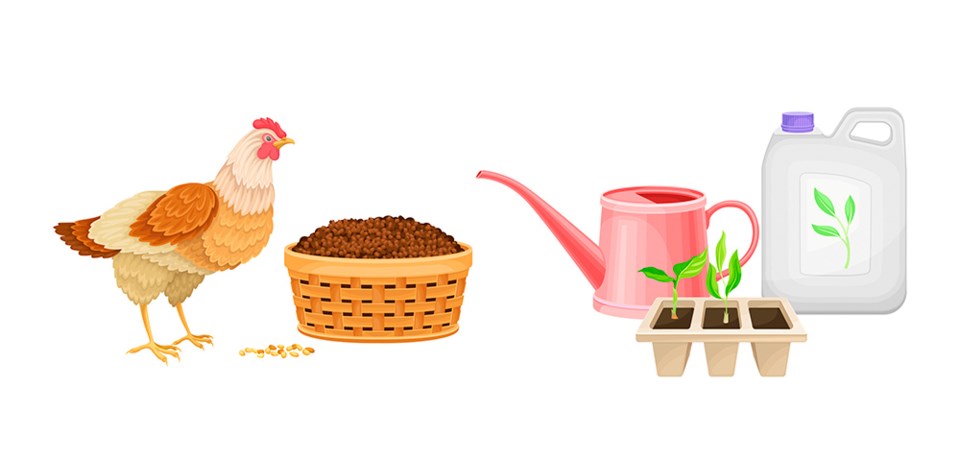If you’re out shopping for your garden supplies this year, you may wonder whether or not to get some fertilizer as well. However, with all the different options, it’s easy to get overwhelmed. Why are there three numbers on the bag and what do they mean? Which one is better for my plants? Should I do organic or synthetic? I’m hoping to answer some of these questions for you in this week’s article.
Every time you grow something in your garden, it takes nutrients out of the soil, most of which are not naturally replaced for the following year. In order to have healthy, lush and productive growth year after year, you may need to add certain nutrients back into the soil for your plants to take up.
Let’s start with the three basic ingredients needed to grow healthy productive plants: nitrogen (N), phosphorous (P) and potassium (K). On bags of synthetic fertilizer, the relative percentage of each of these ingredients is known as the N-P-K ratio and it represented by the numbers you see on the bag. For example, a bag of 10-5-5 fertilizer means it is made up of 10% nitrogen, 5% phosphorous and 5% potassium, with the other 80% being inert ingredients that help distribute the fertilizer and make it easier to take up. Plants need these three nutrients among other smaller nutrients in order to grow healthy roots, robust leaves, flowers, fruit and have good disease resistance.
Nitrogen is probably the most important of the three, as plants use nitrogen in order to build proteins that make up strong vegetative growth such as leaves and stems. It is taken up very easily and quickly out of the soil and tends to be in the shortest supply.
Phosphorous is an important ingredient in developing a strong root system, allowing the plant to form buds, flowers and produce, among other things. A strong root system helps stabilize the plant in the ground and increases winter hardiness for perennials. Phosphorous uptake in plants occurs best when soil is warm and the pH swings on the more acidic side of neutral.
Potassium helps move water and nutrients around the plant as well and plays a key role in photosynthesis, adding to the overall vigour of the plant. Soil moisture plays a role in how well plants can take up potassium. When the soil is moist potassium uptake is better than during a period of drought.
Deficiency in one particular nutrient can be hard to determine, as they can display similar symptoms to each other as well as other environmental setbacks, such as too little/too much water, the wrong pH balance, or not enough sunlight. The only way to truly know what is lacking in your soil is by doing a soil test, which tells you how acidic your soil is as well as what nutrients may or may not be there. You can usually find these kits anywhere garden supplies are sold, or easily online.
Testing your soil not only gives you a better picture of what’s going on in your garden and how to fix it, it also helps prevent over-fertilization, which can end up burning the roots of your plants as well as polluting our waterways during periods of heavy rain.
Testing your soil not only gives you a better picture of what’s going on in your garden and how to fix it, it also helps prevent over-fertilization
There are some rules of thumb when it comes to feeding your plants if you don’t want to get too technical, but still want good results. At the beginning of the growing season, you’ll want to have more nitrogen available so that your plants can grow faster and fill out in your pots or gardens. If you’re buying commercial fertilizer, this would mean that the first number would be the highest out of three in the N-P-K ratio. For your garden veggies, hold off on the nitrogen after a few applications so that they can begin to focus on producing flowers and fruit. If you want to go the organic route, then apply some well-rotted cow or chicken manure (an excellent source of both nitrogen and phosphorous) at least a week before you plant your seedlings. This type of manure is easy to find in the spring at your local hardware and grocery stores, as well as garden centres.
About early-mid growing season, when you want your plants to start flowering and setting buds, change to a ratio that is higher in phosphorous (the middle number). You don’t want to encourage more leafy growth at this point, especially for perennials, because the plant needs time to “harden off” in order to be ready for the winter. Alternatively, sprinkling some bone or fish meal around the base of your plants also increases the amount of phosphorous available for them to take up.
If you want to make sure that your plants have some potassium available for disease/pest resistance and overall vigour, bury some chopped up banana peels around your plants while you’re planting them. These will break down slowly allowing for a steady supply of potassium. If you’ve applied a commercial fertilizer, the amount of potassium already added to the soil during your first applications should be enough for the whole growing season.
How often you fertilize depends on the type of fertilizer you’re using. If you’re going the organic route by spreading manure in the spring, or adding bone meal, fish meal, banana peels, etc. during the growing season, one application a year is enough. If you’re using a commercial fertilizer, follow the directions on the package for the best results. Applications are usually spread out by two-to-four weeks for most fertilizer brands.
Which one is better? That’s a matter of personal preference, there are pros and cons to each. Commercial fertilizers wouldn’t exist if they didn’t do the job well, but they need to be applied on a schedule and can be expensive. Even more so this year, as the Russian war on Ukraine is contributing to global fertilizer shortage.
For my gardens, I personally like to apply organic sources of fertilizer. Not only for the environmental benefits I mentioned earlier, but also because it saves me time and money. Things which are usually in short supply when you have a 14-month-old running around! ◆
Aleksia Shoalts is a Director for the Pelham Garden Club and also writes a blog about gardening and DIY projects. Contact her at [email protected]




